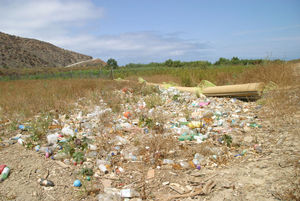I was recently taken on the tour of Border Field State Park that gave me a glimpse into the complicated issues involved in the area on the border between two countries. My tour guide was John Holder, U.S. – Mexico Border Coordinator at WildCoast, a not-for-profit organization based in Imperial Beach dedicated to conserving coastal and marine ecosystems and wildlife.
This project was prompted by a call from a reader that was concerned with the road being closed to cars and the possible sewage water running through the park. Right away I asked Holder about pollution. He is very familiar with the issues. There is definitely a lot of trash from Tijuana that is washed up on the U.S. side of the border specifically in certain areas of Border Field State Park.
Border Field State Park is the southern half of the reserve, an 800 acre park that includes trails, sediment basins, roads and picnic areas. The Tijuana River National Estuarine Research Reserve is one of 27 reserves along the U.S. coast. The reserve is administered by National Oceanic and Atmospheric Administration (NOAA) in partnership with California State Parks. NOAA funds 70 percent of the programs that include education, research, training and stewardship. Within the park there is a 4-acre picnic area, Monument Mesa, which offers restrooms, views of the coast and parking and is located next to the bull ring. Friendship Park is a portion of Monument Mesa picnic area owned by the Federal Department of Homeland Security.
Our first destination was Dairy Mart Bridge where the vegetation was overgrown in some areas and it was hard to see some of the trash that had been washed up during storm events. When we stopped Holder pointed out agricultural fields on the east of the bridge that have suffered flooding damage at times. When we crossed the road I could see some trash under the bridge that had been washed up during past storms. Apart from the trash, the area was dry with no water in sight.
Holder told me different agencies have jurisdiction of the park including city, county and state which is something I had not realized.
As I saw first hand, pollution is a problem. Tires are a big problem. In some areas of Tijuana, tires are used in retaining walls because they are a cheap building material. “WildCoast in partnership with the state has done a tire recycling project on the Mexico side trying to demonstrate there are more cost effective ways to deal with the issue in Mexico,” explained Holder.
WildCoast works with a private company to shred tires after they are collected. Last May WildCoast collected 3,200 tires. This project will continue once a month starting in the fall until next April with the goal of picking up 100,000 tires.
Since the Zika outbreak and the fact that mosquitoes breed in tires this issue has been raised as a serious concern. “We frame the issue as a public health risk,” said Holder.
But what about possible sewage coming on this side of the border? “Generally in the winter months with more rain, there is more of a constant flow, not coming on our side unless there are problems with their pump stations,” said Holder. “The pump stations divert the flow to Punta Bandera 9 km south and discharged directly into the ocean. There are three giant oxidation pumps that discharge 48 to 50 millions of gallons per day.
“In the summer in I.B. there is a constant south swell that brings the water up,” he explained about possible effect in IB. “There is a working group recovery team that is planning a collaboration with Mexico through a government agency or private entity to capture the water, treat it and sell it.”
Holder showed me the three tributaries Yogurt Canyon, Goat Canyon and Smuggler’s Gulch that were dry at the time of our visit because of the time of year. About Smuggler’s Gulch, Holder said, “It’s a natural flood plain impacted by sediment and trash.”
He also showed me the road by Yogurt Canyon, the area that is usually flooded that causes the road to be closed. The Tijuana River Estuarine website says that since the storms in 2005 the topography of the road changed and it is flooded about 5 months of the year and not open to cars. A permanent fix would cost an estimated $4 million. The road is open to cars only on the weekends in the dry season.
“Until the State Park gets money to fix the road it will be an issue,” Holder said. “The reason why it’s closed… since Yogurt Canyon is a tributary, during storms there can be as much as a foot of water [on the road] from rainfall, sewage and waste water.”
We stopped by Goat Canyon where there are two capture basins managed by the California State Park. There I saw bottles, flip flops and various trash. “We would like to see [capture basins] at Dairy Mart Bridge to stop the trash from going into the ocean,” said Holder.
From what I observed those areas are tributaries; they are doing their job of bringing water down into a larger body of water, except that the water that comes down can be polluted and contain trash.
We concluded our tour at Monument Mesa where there are breathtaking views of the coast. The area between the two countries has problems but I was able to see both the beautiful and the ugly sides. On the positive side I learned more about what is being done to make it even more welcoming and picturesque.
Starting Sept. 17 there will be a six week cleanup every Saturday for six weeks as part of the Tijuana River Action Month.





